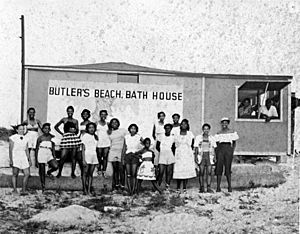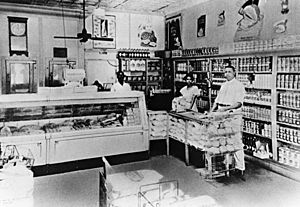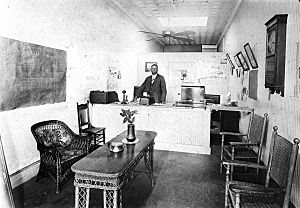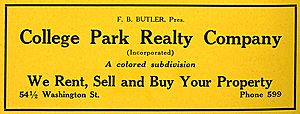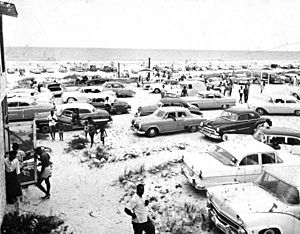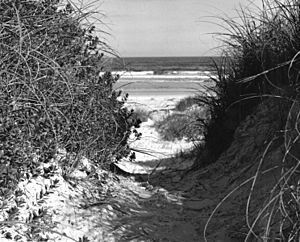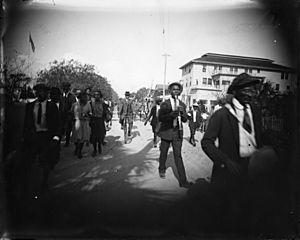Frank B. Butler facts for kids
Frank Bertran Butler (born in 1885, died in 1973) was an American businessman. He created a special beach resort for African Americans in northeast Florida during a time when laws kept people of different races separated. This was known as the segregation era. He worked in Fernandina Beach and St. Augustine. Later, in St. Augustine's Lincolnville neighborhood, he started his own market and a real estate business.
Butler bought land on Anastasia Island that stretched from the Atlantic Ocean to the Matanzas River. Here, he built a beach resort that was open to African Americans. The Tampa Times newspaper said it was the only beach open to them between Jacksonville and Daytona Beach during segregation. This special place became known as Butler Beach. Today, a community and a park are named after him.
Contents
Early Life and First Businesses
Frank Butler was born on August 4, 1885, in Du Pont, Georgia. His mother, Mary Griffin Butler, ran a restaurant for train crews. His father, Frank Butler, Sr., was a fisherman. Frank had four brothers and sisters.
In 1902, when he was seventeen, Butler married Mamie Davis and had a daughter named Minnie Mae. Because there were no good jobs in Du Pont, he moved to Fernandina Beach, Florida, that same year. His wife was not well and sadly passed away soon after. In Fernandina, Butler first worked as a bartender. He later followed his boss to St. Augustine, where he worked in a fish market and as a butcher.
In 1914, Butler opened his own store, the Palace Market, in Lincolnville. It was right next to his home. He sold groceries like meat, flour, milk, and sugar. He mostly served black customers, but some white people also shopped there. The market was very successful.
Building Businesses in Lincolnville
Lincolnville was a black community that grew after the American Civil War. Most African Americans worked as house helpers or laborers. However, some became ministers or started small businesses. After the early 1900s, it became harder for African Americans to vote because of new laws like poll taxes.
In 1915, Butler also started a real estate business. He began buying land in Lincolnville as an investment. By 1923, he was buying land in other areas, especially west of St. Augustine. He developed a neighborhood there called College Park, where many African Americans built their homes. Butler got into real estate during the Florida land boom of the 1920s, when land became very valuable.
During this time, "Jim Crow laws" were in place across the American South, including Florida. These laws enforced racial segregation. Many land deeds sold by other realtors in St. Augustine even said the land could "not be sold to persons of Negro blood." Frank Butler was a friendly person and had friends among the city's white leaders. They sometimes told him about chances to buy land cheaply.
In 1918, the Florida Baptist Academy moved to St. Augustine and was renamed Florida Normal and Industrial Institute. This school taught the ideas of Booker T. Washington. He believed that black people could make progress through education and starting their own businesses. This was seen as a way to improve lives without directly fighting Jim Crow laws. The school helped the community learn about black history and what people could achieve. It was later renamed Florida Memorial College.
Developing Butler Beach
Washington Street was also the social center of Lincolnville. Butler was the president of the Colored Business and Professional Men's League. This group helped black businesses in Lincolnville. In 1925, Butler and others formed the College Park Realty Company, Inc., and he was also its president. This company became one of the most successful real estate businesses in the western part of St. Augustine during the 1920s.
In 1927, Butler started buying undeveloped land on Anastasia Island, about ten miles southeast of St. Augustine. This land was between the Atlantic Ocean and the Matanzas River. He slowly turned this land into "Butler's Beach," a resort area for African Americans. It was the only one of its kind between Jacksonville and Daytona Beach. Some important white leaders helped Butler get loans and develop the land. They wanted African Americans in the county to have a beach to enjoy.
Developing this land was hard because it was sandy and swampy. In 1927, the St. Augustine Record newspaper reported that the county turned down a request for a road to the property. Some white landowners nearby did not want an African American resort built close to their property. A gravel road, which later became State Road A1A, was not built until 1931.
By 1933, local black newspapers advertised trips to Butler Beach for swimming and sports. Buses and cars offered rides for 24 cents. In 1937, Butler announced the grand opening of his "Sea Breeze Kaseno," a new recreation center for black people at Butler's Beach.
The challenges Butler faced in developing his land made him want to get involved in politics. He worked to help people register and vote. Both white and black people voted at poll booths set up in his store. He was active in the Republican Party for many years. Later, he joined the Democratic Party in 1947 after a court decision allowed African Americans to vote in their primary elections.
Over ten years, Butler bought the rest of the land from Edgar Pomar with help from his friends. By 1949, he owned a large strip of land from the ocean to the river.
In 1946, Butler advertised his College Park Subdivision and his resort at Butler's Beach. He improved the beach property along the Matanzas River, making it good for boating, fishing, picnics, and cookouts. He built a pavilion with music and sold refreshments like beer and fried fish. He also had a stand selling hamburgers and shrimp.
Around 1948, after his property was re-planned, black people from St. Augustine, Jacksonville, Georgia, and other places bought lots near the ocean and built homes. The streets in the neighborhood were named after Butler's family members: Mary Street (for his mother), Minnie Street (for his wife and daughter), Mae Street (for his daughter), Rudolph Avenue (for his grandson), and Gloria Avenue (for his granddaughter).
Frank Butler built Butler's Beach Inn, which had fourteen rooms for rent and later eight motel units. His daughter said there were once eleven black-owned businesses at Butler's Beach. These included cafes, an ice cream parlor, and a rooming house. Butler even moved some houses to the beach neighborhood for people to rent or buy. Students from the Florida Normal and Industrial College used to have parties there.
Frank B. Butler State Park
In 1958, Butler's College Park Realty Company sold part of his land to the State of Florida. This land, about half of his total property, was to be used as a state park. It stretched from the ocean to the Matanzas River, south of his community. Butler's daughter said the state wanted to create a park for African Americans.
That same year, Butler was chosen to be on the Frank B. Butler State Advisory Council. He was elected as its chairman and served until 1971. In 1962, the Florida Park Service approved money to build a parking area at the park. In 1963, Butler gave four and a half more acres by the Matanzas River to the state. This created a recreation area for children, making the park a total of fifty-three acres. Other leaders helped to improve the park facilities.
In 1965, Butler advertised his Butler's Beach Inn and Motel, and the nearby state park. He mentioned that the park had "Bar-B-Q grills, picnic tables, clean rest rooms and showers for bathers, as well as Bar-B-Q pits, picnic tables, boat ramp and rest rooms by the river." Reports showed that the park had many visitors, with tens of thousands staying overnight each year.
After Butler passed away in 1973, the park was closed for a while due to damage. His family and others worked hard to get it reopened. In 1980, the state leased the park to St. Johns County for twenty-five years and provided money for its operation. The park was renamed "Frank B. Butler County Park." It was fixed up with picnic tables, barbecue grills, restrooms, and playground equipment. The river was deepened, and the boat ramp was rebuilt. A parking lot, picnic tables, bathrooms, and a walkway over the sand dunes were also added to the beach section.
Community Involvement
Frank Butler was very active in the Lincolnville community throughout his life. He and his family went to St. Paul's African Methodist Episcopal (A.M.E.) Church. He served on the church's Trustee Board for many years and helped the church manage its money. He gave a lot of money to the church and often went to important church meetings. He also helped with Sunday School and often sponsored picnics for children who needed help.
Butler also helped organize the yearly Emancipation Proclamation Day celebrations in Lincolnville. In 1935, he wrote to his state representative asking for state scholarships for black high school graduates. He was also a generous supporter of Florida Normal and Industrial College.
Civil Rights Era
In 1964, Martin Luther King Jr. and his friends, Andrew Young, Ralph Abernathy, and C. T. Vivian, stayed in Butler's motel at the beach. This was during King's visit to St. Augustine for civil rights protests. During their stay, there were violent clashes a few miles away at St. Augustine Beach. White beachgoers did not want African Americans visiting the beaches. Martin Luther King Jr. was photographed near a cottage where he was supposed to stay, which had been shot at.
In the mid-1960s, Butler was part of a committee that worked to help black citizens with their needs, such as improving streets and beaches. He was also appointed to the first committee with both black and white members. This committee was formed to discuss racial problems after the civil rights protests in St. Augustine in the summer of 1964.
Legacy
Frank B. Butler is buried in Woodlawn Cemetery in West St. Augustine. At the end of 1973, the St. Augustine Record newspaper wrote about his death in June as one of the important events of the year. During a time when African Americans faced many challenges in the United States, Butler showed how to succeed in business. He used his influence to help the black community and gave gifts to improve the lives of many people in St. Augustine, both black and white.


